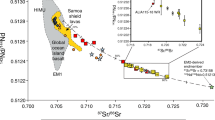Abstract
New data are presented for lavas from the Kamchatka Peninsula and the Aleutian arc. Radiogenic isotopes are strikingly homogeneous in the Kamchatka lavas and although incompatible trace element ratios exhibit much greater variability, much of this appears to result from shallow level, crystal fractionation. The data reveal little systematic across-arc change in radiogenic isotopes or trace element ratios. The Nd and Pb isotope data overlap those for Pacific MORB and limit the amount of sediment that could be incorporated in the mantle source region to <1% which is insufficient to account for the observed La/Ta ratios (50–68) in the high-MgO lavas. The lack of a positive correlation between La/Ta and depth to the slab suggests that melt–wall rock interaction was not important in controlling this ratio. Instead it is inferred that La/Ta increased during partial melting and that DLa/DTa = 0.11–0.06, possibly due to residual amphibole. Ba, U, Sr and Pb were added to the source by an aqueous fluid from the subducting slab and its inferred isotopic composition indicates that this fluid was derived from the altered oceanic crust. The addition of U resulted in a large range of (238U/232Th) from 0.79–2.48 similar to that observed in the Mariana and Lesser Antilles island arcs. However, (230Th/232Th) = 0.79–2.34, and the majority of samples lie close to the equiline indicating that the time since U/Th fractionation is generally ≥150 thousand years. The large width of the volcanic zone is assumed to reflect protracted fluid release from the subducting slab over the depth interval 170–380 km possibly coupled with extension across the Central Kamchatka Depression. The data from the Aleutians contrast strongly with those from Kamchatka. Radiogenic isotope data indicate that the Aleutian lavas contain a significant recycled sedimentary component, consistent with elevated 10Be/9Be ratios. The Aleutian lavas have (230Th/232Th) = 0.79–2.34 and exhibit a significant range of U/Th disequilibria [(238U/230Th) = 0.75–1.01]. However, 10Be/9Be is positively correlated with (238U/230Th) suggesting that the 10Be signal was carried by the aqueous fluid from the slab. The U/Th disequilibria for the Aleutian lavas lie close to a 30 thousand year reference line suggesting that this fluid was released from the slab ∼30 thousand years ago similar to recent estimates from the Lesser Antilles, Marianas, and Tonga-Kermadec island arcs from which it is inferred that fluid addition was the trigger for partial melting. Given that the rate of convergence in Kamchatka is similar to that in the Aleutians, Marianas and Tonga-Kermadec the inferred greater time since␣fluid release in Kamchatka requires further investigation.
Similar content being viewed by others
Author information
Authors and Affiliations
Additional information
Received: 24 September 1997 / Accepted: 7 July 1998
Rights and permissions
About this article
Cite this article
Turner, S., McDermott, F., Hawkesworth, C. et al. A U-series study of lavas from Kamchatka and the Aleutians: constraints on source composition and melting processes. Contrib Mineral Petrol 133, 217–234 (1998). https://doi.org/10.1007/s004100050449
Issue Date:
DOI: https://doi.org/10.1007/s004100050449




